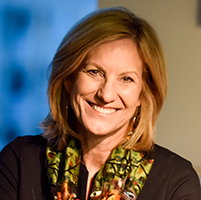7 minutes
Martha Durdin
President/CEO
Canadian Credit Union Association
Toronto
ccua.com
What leadership techniques did you apply to leading the Canadian Credit Union Association during the “you can’t use the word bank” era?
We listened very carefully to our credit unions to make sure that we clearly understood the implications of the directive from the national regulator that would ban credit unions from using the words bank and banking. We pulled together a strong representative team from across Canada and got to work. We worked on our core messaging, what we were advocating for and why. Then we identified and segmented our audiences: government officials, both elected and bureaucrats; the media; our members; and, ultimately, through social media, Canadians in general.
We understood that the system was supportive of our efforts and together I think we ran an effective advocacy campaign. We developed clear and consistent messaging to explain why not being able to explain our business to Canadians, in the vernacular they understand, was clearly a competitive disadvantage. We collected sound data on how much it would cost the credit union system to change signage, websites, marketing materials and legal documents if we were forced to stop using that terminology. Based on input from credit unions, we calculated that it would be to the tune of $80 million.
An integral part of our advocacy was ensuring we spoke with one voice as a system, that all our credit unions used the same messages when advocating with their members of parliament, while also speaking to the implications for their own credit union and their own members. This amplification of messaging was crucial to the successful outcome. As you know, the federal budget tabled in February announced the government’s intent to change the Bank Act legislation and allow credit unions general flexibility in using the banking terminology, which was huge relief to the credit union system.
What did each leadership strategy accomplish?
The leadership strategy I used here was building consensus for our point of view. We wanted consensus among credit unions, naturally, and also among lawmakers, members of parliament and the general public to let credit unions have a fair chance of competing against banks and offer Canadians a cooperative way of banking.
We were successful in building that consensus. We had an outpouring of support from ministers of parliament and Senators who appreciated the challenge we faced and sympathized with our point of view. As I said earlier, bringing everybody together and speaking with one voice was key and the strategy helped us get there.
What would you do differently if you were to lead in a similar situation again in the future?
However successful a strategy turns out, there are always lessons to be learned. To get to our goal, we had to be nimble and continuously look for pointers that would help us assess whether our strategy was working or whether we needed to course-correct.
In my mind, the strategy was crystal clear, and our team knew exactly what we had to do. However, we soon realized that when you’re that close to something, you have to take a step back and look at the bigger picture. We needed to do a better job of explaining our strategy to credit unions in a coherent way to help everyone who had a stake in the outcome understand how we were approaching the issue.
We realized that although we were communicating what needed to get done, we were not communicating the strategy or the why. So, we initiated a weekly conference call and invited any credit union staff who had an interest to participate. We used the call to update them on developments, share best practices and explain next steps. More importantly, it was a way for us to get closer to staff in the credit unions, who were talking to their members in branches, who were engaging with their MPs and with local media. This was a powerful way to ensure that we were all working together toward a common goal. Clearly people appreciated those calls. At one point we had over 100 people joining.
When it came to advocating with the government officials, we knew that we had to push hard, but we also recognized the constraints, and the government’s desire to address the growing fintech sector, so that Canadians understood who they were dealing with. It is always important to understand your target audience, and as much as possible, address their concerns.
In leadership terms, it means being flexible.

“I learned early in my career not to take myself seriously and to surround myself with very smart people.”
Martha Durdin
How would you apply what you learned to a different kind of issue?
Many of the principles are constant and are applicable in different scenarios. For instance, clarity and consistency of message was hugely important. Then you have to find the right space and understand your audience. In case of the bank/banking issue, while negotiating with the government, we had to be mindful of how far they would go, what the limits were.
It is important to get feedback by keeping the dialogue going with your audience. You constantly measure audience reaction—are they heeding your call to action?
How does your leadership through this challenge help make you a more effective leader at CCUA?
I think I learned a lot about credit unions and their commitment to serving their members. And we were able to galvanize credit unions across the country to a common purpose.
So, going through the bank terminology challenge reinforced the importance of following leadership best practices like clarity of vision, listening to counsel, understanding your audience, building consensus and empowering your team by showing them your trust.
Who have been your mentors? What have they taught you?
I’ve been fortunate that I have worked with a number of exemplary leaders in my career. They came from different walks of life, such as public affairs, leaders in politics and government, in small consulting businesses and large multinationals. They all influenced me and helped shape my leadership. I learned about always keeping an eye on your ultimate goal, articulating objectives to your team and together laying out the path to get there, clear and consistent messaging, and being prepared to admit you made a mistake and learning from it, then course correcting but still staying true to your goal. The list goes on.
If I were to call a few people out by name, I do so by apologizing to those whose names I have missed. They all know who they are and they have my undying gratitude.
From Matt Barrett, former CEO, BMO Financial Group, I learned the strength of a great communicator. Jamie Watt at Navigator is a brilliant example of how to support your team, work with and inspire them, and, most of all, make sure you have fun. Senator Joyce Fairbairn taught me the importance of a firm grasp of your business, presenting ideas coherently, bringing your team together to work towards a common goal, making sure people have a clear idea how each one is contributing to that goal, and then tangibly appreciating that individual contribution. I think we all like to know that we are on the right track and that our leaders appreciate our efforts—regardless of the outcome.
One thing I have learned in my career and in life, and something I keep telling my children, is that it doesn’t matter if you fail, it’s how you respond and learn from the experience that matters.
What else helped make you the leader you are today?
Can I say a strong cup of coffee in the morning? And that’s only partially a joke. Talking about jokes, I learned early in my career not to take myself seriously and to surround myself with very smart people.
I am consciously aware that, enjoy it as much as I may, work is still only one part of my life. My family comes first, and I have other interests in life that fulfill me and contribute to my journey as a leader.
So, I take my own advice that I give people in quoting one of the greatest business leaders of our time, Bryon Dyson, former CEO of The Coca-Cola Co.:
“Imagine life as a game in which you are juggling some five balls in the air. You name them work, family, health, friends and spirit. And you’re keeping all of these in the air.
You will soon understand that work is a rubber ball. If you drop it, it will bounce back. But the other four balls—family, health, friends and spirit—are made of glass.
If you drop one of these, they will be irrevocably scuffed, marked, nicked, damaged or even shattered. They will never be the same. You must understand that and strive for balance in your life.”





